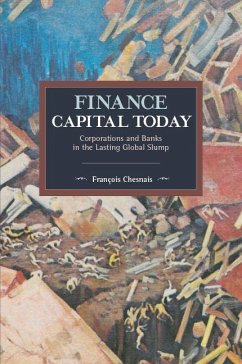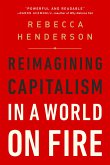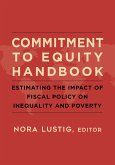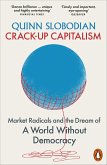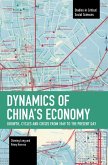- Broschiertes Buch
- Merkliste
- Auf die Merkliste
- Bewerten Bewerten
- Teilen
- Produkt teilen
- Produkterinnerung
- Produkterinnerung
This book presents a rich new analysis of the specific features of contemporary capitalism, notably its global nature and financialization.
Andere Kunden interessierten sich auch für
![Reimagining Capitalism in a World on Fire Reimagining Capitalism in a World on Fire]() Rebecca HendersonReimagining Capitalism in a World on Fire27,99 €
Rebecca HendersonReimagining Capitalism in a World on Fire27,99 €![Commitment to Equity Handbook Commitment to Equity Handbook]() Commitment to Equity Handbook93,99 €
Commitment to Equity Handbook93,99 €![Crack-Up Capitalism Crack-Up Capitalism]() Quinn SlobodianCrack-Up Capitalism9,99 €
Quinn SlobodianCrack-Up Capitalism9,99 €![Dynamics of China's Economy Dynamics of China's Economy]() Zhiming LongDynamics of China's Economy27,99 €
Zhiming LongDynamics of China's Economy27,99 €![Immanent Externalities Immanent Externalities]() Rebecca CarsonImmanent Externalities28,99 €
Rebecca CarsonImmanent Externalities28,99 €![Red-Handed Red-Handed]() Peter SchweizerRed-Handed25,99 €
Peter SchweizerRed-Handed25,99 €![Management and Neoliberalism Management and Neoliberalism]() Alexander StyhreManagement and Neoliberalism59,99 €
Alexander StyhreManagement and Neoliberalism59,99 €-
-
-
This book presents a rich new analysis of the specific features of contemporary capitalism, notably its global nature and financialization.
Hinweis: Dieser Artikel kann nur an eine deutsche Lieferadresse ausgeliefert werden.
Hinweis: Dieser Artikel kann nur an eine deutsche Lieferadresse ausgeliefert werden.
Produktdetails
- Produktdetails
- Verlag: Haymarket Books
- Seitenzahl: 328
- Erscheinungstermin: 2. Januar 2018
- Englisch
- Abmessung: 226mm x 150mm x 18mm
- Gewicht: 454g
- ISBN-13: 9781608468270
- ISBN-10: 1608468275
- Artikelnr.: 47743898
- Herstellerkennzeichnung
- Libri GmbH
- Europaallee 1
- 36244 Bad Hersfeld
- gpsr@libri.de
- Verlag: Haymarket Books
- Seitenzahl: 328
- Erscheinungstermin: 2. Januar 2018
- Englisch
- Abmessung: 226mm x 150mm x 18mm
- Gewicht: 454g
- ISBN-13: 9781608468270
- ISBN-10: 1608468275
- Artikelnr.: 47743898
- Herstellerkennzeichnung
- Libri GmbH
- Europaallee 1
- 36244 Bad Hersfeld
- gpsr@libri.de
François Chesnais is Emeritus Professor at Université-Paris Nord. From La mondialisation du capital (1994) to Les dettes illégitimes (2011), he has written and edited numerous books on financial globalization.
Acknowledgements
Introduction
No end to crisis in view
Finance capital and financial capital
The world economy as an analytical aim
From the theory of the internationalisation of industrial capital to the
theory of financial globalisation
Financialisation as discussed in this book
No 'diversion of profits' but the accumulation of fictitious capital
The 'crisis in the sphere of credit and money' in 2008
1. The Historical Setting of the Crisis and Its Original Traits
1. The Crisis in a Long-Term Trajectory
1.1 In the advanced capitalist countries, slowing accumulation before the
deep break in 2008
1.2 The bourgeoisie's fight against the immanent barriers of capitalist
production
1.3 The fall in the rate of profit and the play of the counteracting
factors
2. A Crisis Which Has Not Been Allowed to Run Its Course
2.1 A mountain of fictitious capital alongside over-accumulation and
overproduction
2.2 Global over-accumulation and overproduction with China as a central
locus
2.3 The globalisation of the labour force, the cornerstone of capital's
strength
2. Financial Liberalisation and Globalisation from the 1960s onwards and
the Return of Financial Crises
1. Industrial Profits and the Eurodollar Market in the Resurgence of
Concentrated Interest-bearing Capital
2. The End of the Bretton Woods Monetary System and the Advent of Floating
Exchange Rates
3. The Recycling of Petrodollars and the Third World Debt Trap
4. The Growth of Government Debt at the Heart of the System
5. The Political Implications of Market-Based Retirement Schemes
6. World Money Since the Demise of Bretton Woods
7. The 'Semi-Completion' of Financial Globalisation and the Financial
Crises of the 1990s
Appendix 2: The 'Club of Paris' and Brady bonds
3. The Notion of Interest-Bearing Capital in the Setting of Present
Centralisation and Concentration of Capital
1. Steps in Approaching the Analysis of Financial Profits
1.1 'Money-dealing' capital, interest-bearing capital and 'financial
accumulation'
1.2 Credit and debt as creating different relationships
1.3 The nature of financial profits
2. Interest-bearing Capital: Exteriority to Production and the Blurring of
Lines between Profit and Interest
2.1 'Capital-as-property' and 'capital-as-function'
2.2 The blurring of lines between profit and interest
3. The Theory of Fictitious Capital
3.1 Fictitious capital: Bonds and shares
3.2. Bank created fictitious capital in its classical form
3.3 The onset and hardening of money fetishism
Appendix 3: The centralisation and concentration of capital in Marxist
theory
4. The Organisational Embodiments of Finance Capital and the
Intra-Corporate Division of Surplus Value
1 A Brief Historical Perspective on the Bank-Industry Relationship
1.1 Germany: The 'unification of capital' and a strong bank influence in
industry
1.2 Money trusts as the US form of finance capital
1.3 The prevalence of imperial financing priorities in Britain
1.4 France: State support to industry and large foreign government loans
2 Contemporary Issues Regarding Corporate Governance and Interlocking
Boards of Directors
2.1 Control under contemporary US corporate governance
2.2 Cross-country interlocking boards of directors and 'transnational
capitalist class formation' in Europe
3 Banks as Merchants and TNCs as Money Capitalists
3.1 The operations of financial conglomerates in commodities trading and
production
3.2 The financial operations of TNCs
4 Concentrated Commodity or Merchant Capital and the Sharing Out of Total
Surplus Value
4.1 The notion of 'profits in circulation'
4.2 Large commodities traders
4.3 Large retailers
5 Natural Resource-based Monopoly Profit and Oil Rent
Appendix 4.1: Control in the ETH Zurich studies
Appendix 4.2: The three major New York investment banks' activities in
commodities
Appendix 4.3: Three examples of industrial corporation ownership of
financial corporations
5. The Internationalisation of Productive Capital and the Formation of
Global Oligopolies
1 The Internationalisation of Productive Capital: Theory and History
1.1 Foreign production of surplus value in the classical theory of
imperialism
1.2 The internationalisation of productive capital in contemporary theory
1.3 Stages in the internationalisation of productive capital
1.4 From horizontal to vertical integration and the intra-corporate
division of labour
1.5 The ownership-location-internalisation theoretical paradigm
2 The Collective Global Monopoly Power of Industrial Capital
2.1 Mergers and acquisitions and the international concentration of capital
2.2 Scant data on domestic concentration and little to none on global
concentration
2.3 Non-price and price competition in global oligopolies
3 The Place of Emerging Countries' Corporations in the Global Oligopoly
3.1 Sovereign wealth funds
3.2 FDI by developing-country TNCs and modes of foreign entry by China,
India and Brazil
Appendix 5: Recent Developments Affecting the Statistical Data on FDI
6. The Operational Modes of TNCs in the 2000s
1 Industrial Capital: From Internationalisation to Globalisation
2 Value Chains in Business Management Theory
3 Buyer-Driven Global Commodity Chains
4 Outsourcing and Offshoring and Global Value Chains in Manufacturing
5 'Non-Equity Modes Of International Production'
6 TNCs and the Present Configuration of World Trade
7 Overexploitation and the 'Global Law of Value'
7. The Accelerated Growth and Further Globalisation of Financial Assets and
Markets
1 Factors Underlying the Growth of Global Financial Transactions
1.1 On the driving forces of financial accumulation again
1.2 Capital flows in and out of the United States
1.3 Intra-Eurozone interbank lending
1.4 The growth and present organisation of foreign exchange trading
2 The Growth of Global Transactions in Derivatives
2.1 A new form of fictitious capital
2.3 The theory of derivatives as the 'contemporary form of world money'
3 Financial Globalisation and Developing Countries in the 2000s
3.1 The diminution of external debt and the renewed attractiveness of
developing countries
3.2 The 'internalisation' of government debt: The case of Brazil
3.3 The audit and cancellation of illegitimate debt by Ecuador
3.4 The 2002 Argentinian default
8. Financialisation and the Transformation of Banking and Credit
1 The Transformation of Banking in the United States
1.1 'Traditional' banking and credit intermediation
1.2 The start of deregulation and the transition to a market-intermediated
credit system
1.3 US bank concentration in the 1990s
2 Financial Liberalisation in Europe and European 'universal banks'
2.1 The course of financial liberalisation in Continental Europe
2.2 Three types of banks in the EU
2.3 The full restoration of the European 'universal bank'
3 Securitisation, the Originate-to-distribute Model and the Shadow Banking
System
3.1 The 'originate-to-distribute' banking model
3.2 The large-scale build-up of fictitious capital on household mortgage
3.3 The shadow banking system
3.4 Global Systemically Important Financial Institutions and the global
banking oligopoly
9. Global Contagion and Systemic Crisis in 2008
1 Investment Banks and Hedge Funds
1.1 High-risk leverage driven by low profitability
1.2 Investment banks
1.3 Hedge funds: The absence of regulation as a key enabling feature
1.4 Highly leveraged speculative investments alongside 'vulture' hedge fund
operations
1.5 Investment banks' proprietary trading and prime brokerage for hedge
funds
2 The Channels of International Financial Contagion
2.1 The channels of international financial contagion in the 1990s
2.2 Contagion through the transatlantic shadow banking system
3 Specific Systemic Vulnerability in the European Banking System
3.1 The Maastricht Treaty construction
3.2 Asymmetric intra-European relationships and the effects of shadow
banking
3.3 From imported to self-generated financial crisis in the EU
3.4 Greece as an in vivo political and social experiment
10. Global Endemic Financial Instability
1 The Effects and Potential Backlashes of Quantitative Easing
2 The Very Long Continuous Fall in Interest Rates and the Growth of Debt
3 Non-Bank Financial Corporations and Systemic Contagion Risks Today
4 The Potential for Financial Turmoil in Emerging Countries
Conclusion
The institutional difficulties of doing Marxist economic research
Persistent very low global growth coupled with endemic financial
instability
How could slow growth be brought to an end and a new long upswing start?
The convergence of global economic and ecological crisis
Non-ecological approaches to the notion of capitalism's possible absolute
limits
The advent of a new more formidable immanent barrier and its implications
References
Glossary
Index
Introduction
No end to crisis in view
Finance capital and financial capital
The world economy as an analytical aim
From the theory of the internationalisation of industrial capital to the
theory of financial globalisation
Financialisation as discussed in this book
No 'diversion of profits' but the accumulation of fictitious capital
The 'crisis in the sphere of credit and money' in 2008
1. The Historical Setting of the Crisis and Its Original Traits
1. The Crisis in a Long-Term Trajectory
1.1 In the advanced capitalist countries, slowing accumulation before the
deep break in 2008
1.2 The bourgeoisie's fight against the immanent barriers of capitalist
production
1.3 The fall in the rate of profit and the play of the counteracting
factors
2. A Crisis Which Has Not Been Allowed to Run Its Course
2.1 A mountain of fictitious capital alongside over-accumulation and
overproduction
2.2 Global over-accumulation and overproduction with China as a central
locus
2.3 The globalisation of the labour force, the cornerstone of capital's
strength
2. Financial Liberalisation and Globalisation from the 1960s onwards and
the Return of Financial Crises
1. Industrial Profits and the Eurodollar Market in the Resurgence of
Concentrated Interest-bearing Capital
2. The End of the Bretton Woods Monetary System and the Advent of Floating
Exchange Rates
3. The Recycling of Petrodollars and the Third World Debt Trap
4. The Growth of Government Debt at the Heart of the System
5. The Political Implications of Market-Based Retirement Schemes
6. World Money Since the Demise of Bretton Woods
7. The 'Semi-Completion' of Financial Globalisation and the Financial
Crises of the 1990s
Appendix 2: The 'Club of Paris' and Brady bonds
3. The Notion of Interest-Bearing Capital in the Setting of Present
Centralisation and Concentration of Capital
1. Steps in Approaching the Analysis of Financial Profits
1.1 'Money-dealing' capital, interest-bearing capital and 'financial
accumulation'
1.2 Credit and debt as creating different relationships
1.3 The nature of financial profits
2. Interest-bearing Capital: Exteriority to Production and the Blurring of
Lines between Profit and Interest
2.1 'Capital-as-property' and 'capital-as-function'
2.2 The blurring of lines between profit and interest
3. The Theory of Fictitious Capital
3.1 Fictitious capital: Bonds and shares
3.2. Bank created fictitious capital in its classical form
3.3 The onset and hardening of money fetishism
Appendix 3: The centralisation and concentration of capital in Marxist
theory
4. The Organisational Embodiments of Finance Capital and the
Intra-Corporate Division of Surplus Value
1 A Brief Historical Perspective on the Bank-Industry Relationship
1.1 Germany: The 'unification of capital' and a strong bank influence in
industry
1.2 Money trusts as the US form of finance capital
1.3 The prevalence of imperial financing priorities in Britain
1.4 France: State support to industry and large foreign government loans
2 Contemporary Issues Regarding Corporate Governance and Interlocking
Boards of Directors
2.1 Control under contemporary US corporate governance
2.2 Cross-country interlocking boards of directors and 'transnational
capitalist class formation' in Europe
3 Banks as Merchants and TNCs as Money Capitalists
3.1 The operations of financial conglomerates in commodities trading and
production
3.2 The financial operations of TNCs
4 Concentrated Commodity or Merchant Capital and the Sharing Out of Total
Surplus Value
4.1 The notion of 'profits in circulation'
4.2 Large commodities traders
4.3 Large retailers
5 Natural Resource-based Monopoly Profit and Oil Rent
Appendix 4.1: Control in the ETH Zurich studies
Appendix 4.2: The three major New York investment banks' activities in
commodities
Appendix 4.3: Three examples of industrial corporation ownership of
financial corporations
5. The Internationalisation of Productive Capital and the Formation of
Global Oligopolies
1 The Internationalisation of Productive Capital: Theory and History
1.1 Foreign production of surplus value in the classical theory of
imperialism
1.2 The internationalisation of productive capital in contemporary theory
1.3 Stages in the internationalisation of productive capital
1.4 From horizontal to vertical integration and the intra-corporate
division of labour
1.5 The ownership-location-internalisation theoretical paradigm
2 The Collective Global Monopoly Power of Industrial Capital
2.1 Mergers and acquisitions and the international concentration of capital
2.2 Scant data on domestic concentration and little to none on global
concentration
2.3 Non-price and price competition in global oligopolies
3 The Place of Emerging Countries' Corporations in the Global Oligopoly
3.1 Sovereign wealth funds
3.2 FDI by developing-country TNCs and modes of foreign entry by China,
India and Brazil
Appendix 5: Recent Developments Affecting the Statistical Data on FDI
6. The Operational Modes of TNCs in the 2000s
1 Industrial Capital: From Internationalisation to Globalisation
2 Value Chains in Business Management Theory
3 Buyer-Driven Global Commodity Chains
4 Outsourcing and Offshoring and Global Value Chains in Manufacturing
5 'Non-Equity Modes Of International Production'
6 TNCs and the Present Configuration of World Trade
7 Overexploitation and the 'Global Law of Value'
7. The Accelerated Growth and Further Globalisation of Financial Assets and
Markets
1 Factors Underlying the Growth of Global Financial Transactions
1.1 On the driving forces of financial accumulation again
1.2 Capital flows in and out of the United States
1.3 Intra-Eurozone interbank lending
1.4 The growth and present organisation of foreign exchange trading
2 The Growth of Global Transactions in Derivatives
2.1 A new form of fictitious capital
2.3 The theory of derivatives as the 'contemporary form of world money'
3 Financial Globalisation and Developing Countries in the 2000s
3.1 The diminution of external debt and the renewed attractiveness of
developing countries
3.2 The 'internalisation' of government debt: The case of Brazil
3.3 The audit and cancellation of illegitimate debt by Ecuador
3.4 The 2002 Argentinian default
8. Financialisation and the Transformation of Banking and Credit
1 The Transformation of Banking in the United States
1.1 'Traditional' banking and credit intermediation
1.2 The start of deregulation and the transition to a market-intermediated
credit system
1.3 US bank concentration in the 1990s
2 Financial Liberalisation in Europe and European 'universal banks'
2.1 The course of financial liberalisation in Continental Europe
2.2 Three types of banks in the EU
2.3 The full restoration of the European 'universal bank'
3 Securitisation, the Originate-to-distribute Model and the Shadow Banking
System
3.1 The 'originate-to-distribute' banking model
3.2 The large-scale build-up of fictitious capital on household mortgage
3.3 The shadow banking system
3.4 Global Systemically Important Financial Institutions and the global
banking oligopoly
9. Global Contagion and Systemic Crisis in 2008
1 Investment Banks and Hedge Funds
1.1 High-risk leverage driven by low profitability
1.2 Investment banks
1.3 Hedge funds: The absence of regulation as a key enabling feature
1.4 Highly leveraged speculative investments alongside 'vulture' hedge fund
operations
1.5 Investment banks' proprietary trading and prime brokerage for hedge
funds
2 The Channels of International Financial Contagion
2.1 The channels of international financial contagion in the 1990s
2.2 Contagion through the transatlantic shadow banking system
3 Specific Systemic Vulnerability in the European Banking System
3.1 The Maastricht Treaty construction
3.2 Asymmetric intra-European relationships and the effects of shadow
banking
3.3 From imported to self-generated financial crisis in the EU
3.4 Greece as an in vivo political and social experiment
10. Global Endemic Financial Instability
1 The Effects and Potential Backlashes of Quantitative Easing
2 The Very Long Continuous Fall in Interest Rates and the Growth of Debt
3 Non-Bank Financial Corporations and Systemic Contagion Risks Today
4 The Potential for Financial Turmoil in Emerging Countries
Conclusion
The institutional difficulties of doing Marxist economic research
Persistent very low global growth coupled with endemic financial
instability
How could slow growth be brought to an end and a new long upswing start?
The convergence of global economic and ecological crisis
Non-ecological approaches to the notion of capitalism's possible absolute
limits
The advent of a new more formidable immanent barrier and its implications
References
Glossary
Index
Acknowledgements
Introduction
No end to crisis in view
Finance capital and financial capital
The world economy as an analytical aim
From the theory of the internationalisation of industrial capital to the
theory of financial globalisation
Financialisation as discussed in this book
No 'diversion of profits' but the accumulation of fictitious capital
The 'crisis in the sphere of credit and money' in 2008
1. The Historical Setting of the Crisis and Its Original Traits
1. The Crisis in a Long-Term Trajectory
1.1 In the advanced capitalist countries, slowing accumulation before the
deep break in 2008
1.2 The bourgeoisie's fight against the immanent barriers of capitalist
production
1.3 The fall in the rate of profit and the play of the counteracting
factors
2. A Crisis Which Has Not Been Allowed to Run Its Course
2.1 A mountain of fictitious capital alongside over-accumulation and
overproduction
2.2 Global over-accumulation and overproduction with China as a central
locus
2.3 The globalisation of the labour force, the cornerstone of capital's
strength
2. Financial Liberalisation and Globalisation from the 1960s onwards and
the Return of Financial Crises
1. Industrial Profits and the Eurodollar Market in the Resurgence of
Concentrated Interest-bearing Capital
2. The End of the Bretton Woods Monetary System and the Advent of Floating
Exchange Rates
3. The Recycling of Petrodollars and the Third World Debt Trap
4. The Growth of Government Debt at the Heart of the System
5. The Political Implications of Market-Based Retirement Schemes
6. World Money Since the Demise of Bretton Woods
7. The 'Semi-Completion' of Financial Globalisation and the Financial
Crises of the 1990s
Appendix 2: The 'Club of Paris' and Brady bonds
3. The Notion of Interest-Bearing Capital in the Setting of Present
Centralisation and Concentration of Capital
1. Steps in Approaching the Analysis of Financial Profits
1.1 'Money-dealing' capital, interest-bearing capital and 'financial
accumulation'
1.2 Credit and debt as creating different relationships
1.3 The nature of financial profits
2. Interest-bearing Capital: Exteriority to Production and the Blurring of
Lines between Profit and Interest
2.1 'Capital-as-property' and 'capital-as-function'
2.2 The blurring of lines between profit and interest
3. The Theory of Fictitious Capital
3.1 Fictitious capital: Bonds and shares
3.2. Bank created fictitious capital in its classical form
3.3 The onset and hardening of money fetishism
Appendix 3: The centralisation and concentration of capital in Marxist
theory
4. The Organisational Embodiments of Finance Capital and the
Intra-Corporate Division of Surplus Value
1 A Brief Historical Perspective on the Bank-Industry Relationship
1.1 Germany: The 'unification of capital' and a strong bank influence in
industry
1.2 Money trusts as the US form of finance capital
1.3 The prevalence of imperial financing priorities in Britain
1.4 France: State support to industry and large foreign government loans
2 Contemporary Issues Regarding Corporate Governance and Interlocking
Boards of Directors
2.1 Control under contemporary US corporate governance
2.2 Cross-country interlocking boards of directors and 'transnational
capitalist class formation' in Europe
3 Banks as Merchants and TNCs as Money Capitalists
3.1 The operations of financial conglomerates in commodities trading and
production
3.2 The financial operations of TNCs
4 Concentrated Commodity or Merchant Capital and the Sharing Out of Total
Surplus Value
4.1 The notion of 'profits in circulation'
4.2 Large commodities traders
4.3 Large retailers
5 Natural Resource-based Monopoly Profit and Oil Rent
Appendix 4.1: Control in the ETH Zurich studies
Appendix 4.2: The three major New York investment banks' activities in
commodities
Appendix 4.3: Three examples of industrial corporation ownership of
financial corporations
5. The Internationalisation of Productive Capital and the Formation of
Global Oligopolies
1 The Internationalisation of Productive Capital: Theory and History
1.1 Foreign production of surplus value in the classical theory of
imperialism
1.2 The internationalisation of productive capital in contemporary theory
1.3 Stages in the internationalisation of productive capital
1.4 From horizontal to vertical integration and the intra-corporate
division of labour
1.5 The ownership-location-internalisation theoretical paradigm
2 The Collective Global Monopoly Power of Industrial Capital
2.1 Mergers and acquisitions and the international concentration of capital
2.2 Scant data on domestic concentration and little to none on global
concentration
2.3 Non-price and price competition in global oligopolies
3 The Place of Emerging Countries' Corporations in the Global Oligopoly
3.1 Sovereign wealth funds
3.2 FDI by developing-country TNCs and modes of foreign entry by China,
India and Brazil
Appendix 5: Recent Developments Affecting the Statistical Data on FDI
6. The Operational Modes of TNCs in the 2000s
1 Industrial Capital: From Internationalisation to Globalisation
2 Value Chains in Business Management Theory
3 Buyer-Driven Global Commodity Chains
4 Outsourcing and Offshoring and Global Value Chains in Manufacturing
5 'Non-Equity Modes Of International Production'
6 TNCs and the Present Configuration of World Trade
7 Overexploitation and the 'Global Law of Value'
7. The Accelerated Growth and Further Globalisation of Financial Assets and
Markets
1 Factors Underlying the Growth of Global Financial Transactions
1.1 On the driving forces of financial accumulation again
1.2 Capital flows in and out of the United States
1.3 Intra-Eurozone interbank lending
1.4 The growth and present organisation of foreign exchange trading
2 The Growth of Global Transactions in Derivatives
2.1 A new form of fictitious capital
2.3 The theory of derivatives as the 'contemporary form of world money'
3 Financial Globalisation and Developing Countries in the 2000s
3.1 The diminution of external debt and the renewed attractiveness of
developing countries
3.2 The 'internalisation' of government debt: The case of Brazil
3.3 The audit and cancellation of illegitimate debt by Ecuador
3.4 The 2002 Argentinian default
8. Financialisation and the Transformation of Banking and Credit
1 The Transformation of Banking in the United States
1.1 'Traditional' banking and credit intermediation
1.2 The start of deregulation and the transition to a market-intermediated
credit system
1.3 US bank concentration in the 1990s
2 Financial Liberalisation in Europe and European 'universal banks'
2.1 The course of financial liberalisation in Continental Europe
2.2 Three types of banks in the EU
2.3 The full restoration of the European 'universal bank'
3 Securitisation, the Originate-to-distribute Model and the Shadow Banking
System
3.1 The 'originate-to-distribute' banking model
3.2 The large-scale build-up of fictitious capital on household mortgage
3.3 The shadow banking system
3.4 Global Systemically Important Financial Institutions and the global
banking oligopoly
9. Global Contagion and Systemic Crisis in 2008
1 Investment Banks and Hedge Funds
1.1 High-risk leverage driven by low profitability
1.2 Investment banks
1.3 Hedge funds: The absence of regulation as a key enabling feature
1.4 Highly leveraged speculative investments alongside 'vulture' hedge fund
operations
1.5 Investment banks' proprietary trading and prime brokerage for hedge
funds
2 The Channels of International Financial Contagion
2.1 The channels of international financial contagion in the 1990s
2.2 Contagion through the transatlantic shadow banking system
3 Specific Systemic Vulnerability in the European Banking System
3.1 The Maastricht Treaty construction
3.2 Asymmetric intra-European relationships and the effects of shadow
banking
3.3 From imported to self-generated financial crisis in the EU
3.4 Greece as an in vivo political and social experiment
10. Global Endemic Financial Instability
1 The Effects and Potential Backlashes of Quantitative Easing
2 The Very Long Continuous Fall in Interest Rates and the Growth of Debt
3 Non-Bank Financial Corporations and Systemic Contagion Risks Today
4 The Potential for Financial Turmoil in Emerging Countries
Conclusion
The institutional difficulties of doing Marxist economic research
Persistent very low global growth coupled with endemic financial
instability
How could slow growth be brought to an end and a new long upswing start?
The convergence of global economic and ecological crisis
Non-ecological approaches to the notion of capitalism's possible absolute
limits
The advent of a new more formidable immanent barrier and its implications
References
Glossary
Index
Introduction
No end to crisis in view
Finance capital and financial capital
The world economy as an analytical aim
From the theory of the internationalisation of industrial capital to the
theory of financial globalisation
Financialisation as discussed in this book
No 'diversion of profits' but the accumulation of fictitious capital
The 'crisis in the sphere of credit and money' in 2008
1. The Historical Setting of the Crisis and Its Original Traits
1. The Crisis in a Long-Term Trajectory
1.1 In the advanced capitalist countries, slowing accumulation before the
deep break in 2008
1.2 The bourgeoisie's fight against the immanent barriers of capitalist
production
1.3 The fall in the rate of profit and the play of the counteracting
factors
2. A Crisis Which Has Not Been Allowed to Run Its Course
2.1 A mountain of fictitious capital alongside over-accumulation and
overproduction
2.2 Global over-accumulation and overproduction with China as a central
locus
2.3 The globalisation of the labour force, the cornerstone of capital's
strength
2. Financial Liberalisation and Globalisation from the 1960s onwards and
the Return of Financial Crises
1. Industrial Profits and the Eurodollar Market in the Resurgence of
Concentrated Interest-bearing Capital
2. The End of the Bretton Woods Monetary System and the Advent of Floating
Exchange Rates
3. The Recycling of Petrodollars and the Third World Debt Trap
4. The Growth of Government Debt at the Heart of the System
5. The Political Implications of Market-Based Retirement Schemes
6. World Money Since the Demise of Bretton Woods
7. The 'Semi-Completion' of Financial Globalisation and the Financial
Crises of the 1990s
Appendix 2: The 'Club of Paris' and Brady bonds
3. The Notion of Interest-Bearing Capital in the Setting of Present
Centralisation and Concentration of Capital
1. Steps in Approaching the Analysis of Financial Profits
1.1 'Money-dealing' capital, interest-bearing capital and 'financial
accumulation'
1.2 Credit and debt as creating different relationships
1.3 The nature of financial profits
2. Interest-bearing Capital: Exteriority to Production and the Blurring of
Lines between Profit and Interest
2.1 'Capital-as-property' and 'capital-as-function'
2.2 The blurring of lines between profit and interest
3. The Theory of Fictitious Capital
3.1 Fictitious capital: Bonds and shares
3.2. Bank created fictitious capital in its classical form
3.3 The onset and hardening of money fetishism
Appendix 3: The centralisation and concentration of capital in Marxist
theory
4. The Organisational Embodiments of Finance Capital and the
Intra-Corporate Division of Surplus Value
1 A Brief Historical Perspective on the Bank-Industry Relationship
1.1 Germany: The 'unification of capital' and a strong bank influence in
industry
1.2 Money trusts as the US form of finance capital
1.3 The prevalence of imperial financing priorities in Britain
1.4 France: State support to industry and large foreign government loans
2 Contemporary Issues Regarding Corporate Governance and Interlocking
Boards of Directors
2.1 Control under contemporary US corporate governance
2.2 Cross-country interlocking boards of directors and 'transnational
capitalist class formation' in Europe
3 Banks as Merchants and TNCs as Money Capitalists
3.1 The operations of financial conglomerates in commodities trading and
production
3.2 The financial operations of TNCs
4 Concentrated Commodity or Merchant Capital and the Sharing Out of Total
Surplus Value
4.1 The notion of 'profits in circulation'
4.2 Large commodities traders
4.3 Large retailers
5 Natural Resource-based Monopoly Profit and Oil Rent
Appendix 4.1: Control in the ETH Zurich studies
Appendix 4.2: The three major New York investment banks' activities in
commodities
Appendix 4.3: Three examples of industrial corporation ownership of
financial corporations
5. The Internationalisation of Productive Capital and the Formation of
Global Oligopolies
1 The Internationalisation of Productive Capital: Theory and History
1.1 Foreign production of surplus value in the classical theory of
imperialism
1.2 The internationalisation of productive capital in contemporary theory
1.3 Stages in the internationalisation of productive capital
1.4 From horizontal to vertical integration and the intra-corporate
division of labour
1.5 The ownership-location-internalisation theoretical paradigm
2 The Collective Global Monopoly Power of Industrial Capital
2.1 Mergers and acquisitions and the international concentration of capital
2.2 Scant data on domestic concentration and little to none on global
concentration
2.3 Non-price and price competition in global oligopolies
3 The Place of Emerging Countries' Corporations in the Global Oligopoly
3.1 Sovereign wealth funds
3.2 FDI by developing-country TNCs and modes of foreign entry by China,
India and Brazil
Appendix 5: Recent Developments Affecting the Statistical Data on FDI
6. The Operational Modes of TNCs in the 2000s
1 Industrial Capital: From Internationalisation to Globalisation
2 Value Chains in Business Management Theory
3 Buyer-Driven Global Commodity Chains
4 Outsourcing and Offshoring and Global Value Chains in Manufacturing
5 'Non-Equity Modes Of International Production'
6 TNCs and the Present Configuration of World Trade
7 Overexploitation and the 'Global Law of Value'
7. The Accelerated Growth and Further Globalisation of Financial Assets and
Markets
1 Factors Underlying the Growth of Global Financial Transactions
1.1 On the driving forces of financial accumulation again
1.2 Capital flows in and out of the United States
1.3 Intra-Eurozone interbank lending
1.4 The growth and present organisation of foreign exchange trading
2 The Growth of Global Transactions in Derivatives
2.1 A new form of fictitious capital
2.3 The theory of derivatives as the 'contemporary form of world money'
3 Financial Globalisation and Developing Countries in the 2000s
3.1 The diminution of external debt and the renewed attractiveness of
developing countries
3.2 The 'internalisation' of government debt: The case of Brazil
3.3 The audit and cancellation of illegitimate debt by Ecuador
3.4 The 2002 Argentinian default
8. Financialisation and the Transformation of Banking and Credit
1 The Transformation of Banking in the United States
1.1 'Traditional' banking and credit intermediation
1.2 The start of deregulation and the transition to a market-intermediated
credit system
1.3 US bank concentration in the 1990s
2 Financial Liberalisation in Europe and European 'universal banks'
2.1 The course of financial liberalisation in Continental Europe
2.2 Three types of banks in the EU
2.3 The full restoration of the European 'universal bank'
3 Securitisation, the Originate-to-distribute Model and the Shadow Banking
System
3.1 The 'originate-to-distribute' banking model
3.2 The large-scale build-up of fictitious capital on household mortgage
3.3 The shadow banking system
3.4 Global Systemically Important Financial Institutions and the global
banking oligopoly
9. Global Contagion and Systemic Crisis in 2008
1 Investment Banks and Hedge Funds
1.1 High-risk leverage driven by low profitability
1.2 Investment banks
1.3 Hedge funds: The absence of regulation as a key enabling feature
1.4 Highly leveraged speculative investments alongside 'vulture' hedge fund
operations
1.5 Investment banks' proprietary trading and prime brokerage for hedge
funds
2 The Channels of International Financial Contagion
2.1 The channels of international financial contagion in the 1990s
2.2 Contagion through the transatlantic shadow banking system
3 Specific Systemic Vulnerability in the European Banking System
3.1 The Maastricht Treaty construction
3.2 Asymmetric intra-European relationships and the effects of shadow
banking
3.3 From imported to self-generated financial crisis in the EU
3.4 Greece as an in vivo political and social experiment
10. Global Endemic Financial Instability
1 The Effects and Potential Backlashes of Quantitative Easing
2 The Very Long Continuous Fall in Interest Rates and the Growth of Debt
3 Non-Bank Financial Corporations and Systemic Contagion Risks Today
4 The Potential for Financial Turmoil in Emerging Countries
Conclusion
The institutional difficulties of doing Marxist economic research
Persistent very low global growth coupled with endemic financial
instability
How could slow growth be brought to an end and a new long upswing start?
The convergence of global economic and ecological crisis
Non-ecological approaches to the notion of capitalism's possible absolute
limits
The advent of a new more formidable immanent barrier and its implications
References
Glossary
Index

